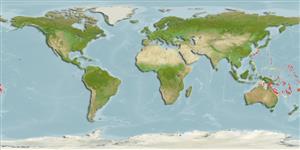>
Gobiiformes (Gobies) >
Gobiidae (Gobies) > Gobiinae
Etymology: Trimma: Greek, trimma, -atos = something crushed (Ref. 45335); pentherum: Name from Greek 'pentheros' meaning 'of mourning', apparently alluding to the black bar on the pectoral-fin base which, with considerable imagination, could be viewed as analogous to the black arm band worn to signify the death of a close friend or relative in certain cultures.
Environment: milieu / climate zone / profondeur / distribution range
Écologie
marin récifal; profondeur 0 - 24 m (Ref. 100726). Tropical
Western Pacific: Australia (the Great Barrier Reef) to Tonga and north to the South West Islands of Palau.
Taille / Poids / Âge
Maturité: Lm ? range ? - ? cm
Max length : 2.0 cm SL mâle / non sexé; (Ref. 100726)
Description synthétique
Clés d'identification | Morphologie | Morphométrie
Épines dorsales (Total) : 7; Rayons mous dorsaux (Total) : 8; Épines anales: 1; Rayons mous anaux: 8. This species is distinguished by the following characters: a concave bony interorbital which is less than half pupil-diameter in width; slight or no groove posterodorsal to eye; presence of scales in the midline of the predorsal region; absence of opercular scales; the fifth pelvic ray is branched once dichotomously and more than 80% the length of the fourth ray; adults with the epaxial musculature reaching anteromedially to a point in line with the posterior margin of the eye; elongated spines in first dorsal fin absent (the second spine is longest, reaching to the region of the base of the second dorsal-fin spine); scale pockets are strongly outlined by melanophores and chromatophores; with a dark, vertical bar on the base of the pectoral fin; 6 grey saddles across the dorsum (Ref. 100726).
Body shape (shape guide): fusiform / normal; Cross section: oval.
Life cycle and mating behavior
Maturité | Reproduction | Frai | Œufs | Fécondité | Larves
Winterbottom, R. and D.F. Hoese, 2015. A revision of the Australian species of Trimma (Actinopterygii, Gobiidae), with descriptions of six new species and redescriptions of twenty-three valid species. Zootaxa 3934(1):001-102. (Ref. 100726)
Statut dans la liste rouge de l'IUCN (Ref. 130435: Version 2025-1)
Menace pour l'homme
Harmless
Utilisations par l'homme
Pêcheries: sans intérêt
Outils
Articles particuliers
Télécharger en XML
Sources Internet
Estimates based on models
Phylogenetic diversity index (Réf.
82804): PD
50 = 0.5000 [Uniqueness, from 0.5 = low to 2.0 = high].
Bayesian length-weight: a=0.01023 (0.00477 - 0.02194), b=3.01 (2.83 - 3.19), in cm total length, based on LWR estimates for this (Sub)family-body shape (Ref.
93245).
Résilience (Réf.
120179): Haut, temps minimum de doublement de population inférieur à 15 mois (Preliminary K or Fecundity.).
Fishing Vulnerability (Ref.
59153): Low vulnerability (10 of 100).
🛈
